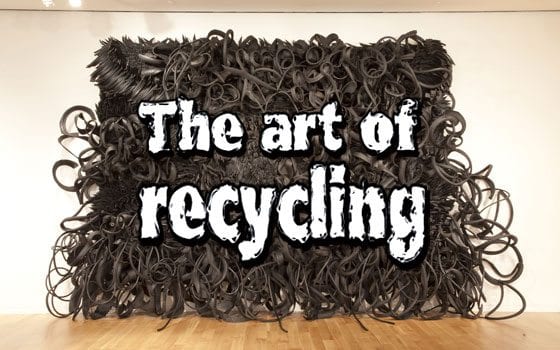Chakaia Booker’s sculptures convey defiant resilience against harsh odds and in particular, the endurance of black Americans


Author: Marlborough Galleryarts41b.jpg

Author: Marlborough Galleryarts41c.jpg
Chakaia Booker’s sculptures convey defiant resilience against harsh odds and in particular, the endurance of black Americans
Chakaia Booker’s sculptures give new life to spent material — bald, threadbare and blown-out tires. Chopped, knotted, twisted and bolted in intricate layers onto wood or steel frames, the strips of cast-off rubber become figures that seethe with energy.
Thirty of Booker’s works from the 1990s to the present are on display through August 29 in an absorbing exhibition that occupies the galleries, outdoor terraces and wooded grounds of the DeCordova Sculpture Park and Museum in Lincoln, Mass. Booker’s largest solo exhibition to date, “Chakaia Booker: In and Out” inaugurates the museum’s new series of annual summer shows featuring important contemporary sculptors. Organized by Senior Curator Nick Capasso, it is accompanied by a full-color catalogue.
An African American artist born in Newark and living in New York City, Booker, 57, finds enormous expressive power in the textures, shapes and black-on-black palette of worn-out tires.
Making something new out of discarded material, her works convey defiant resilience against harsh odds and in particular, the endurance of black Americans.
While her sculptures incorporate modernist values of abstraction and minimalism with their strong forms, she also endows her works with suggestive shapes and wildly textured surfaces.
Her sculptures generate tension by bringing unlike characteristics together. Merging the clear, strong lines of geometric forms with richly textured surfaces that evoke the Baroque excess found in nature, the works restore rubber, an industrial byproduct of oil, to its original connection with nature.
Displayed outdoors in the forested grounds of the sculpture park, Booker’s works are in harmony with their surroundings. The treaded layers that coat her sculptures like reptilian skins echo the dense, repetitive patterns of leaves in nearby vines and trees.
Many of the sculptures are monumental in scale — from 10 to 20 feet tall. Smaller works on view indoors seem to sprout from the gallery walls.
Dominated by spirals and curves, her sculptures never stray far from the original circular form of her source material.
A curved work’s concave side is often coated with pieces of a tire’s glossy inner skins, which lend the surface a smooth sheen. Usually the figure’s outer layer is a stack of treaded strips cut in tongues that resemble spikes or quills.
Booker’s sculptures are often playful in shape but aggressive in mood and stance. Some are biomorphic figures that suggest classical statuary injected with urban attitude. Her work “Untitled (Male Torso That Left His Path)” (1992-95) resembles a classical reclining nude; but its bulging, muscular backside calls to mind a clenched fist.
Other sculptures evoke fetishistic archetypes or such organisms as insects, seahorses and hulking beasts.
In one work, the brands of the tires are visible, perhaps a nod to early American Modernists and their Pop art successors, who co-opted advertising logos as raw material.
Words are part of the expressive repertoire used by Booker, who coyly labels her works. “Twist of Fate” (2003) is a writhing knot of black rubber. “The Fatality of Hope” (2007) is a maze of rubber strips in serpentine loops and filigrees that interlace with each other and their shadows.
Whether compact or commanding in scale, many of Booker’s works have a textural finesse that rewards a close-up look. She weaves a fragile patch of worn rubber that resembles lace into the sculpture “Crossed Vagina” (2001). In a large outdoor sculpture, the threads on the edges of the sliced tires glint like strands of gold; and the metal bolts that fasten the slices in place lend the work a silver-on-black effect of goth beauty.
“Gridlock” (2008) is one of several sculptures that seem to shimmy in a ritualistic dance. Two identical figures that stand about 10 feet apart, the pair curve in parallel, their spines resembling thick bamboo trunks.
The silhouette of a pedestal-mounted figure, “Mixed Message” (2005) kindles an image of a granny sorceress in a rocking chair. Crowned by a wad of rubber strips that resembles a ball of yarn, its rotund body is adorned with necklace-like ropes that cascade to the floor in long tendrils like so many spells.
Using scrap material to create something new, Booker’s sculptures honor the capacity to survive with economy and sardonic humor.
“Dorothy Shoes” (1994), a small construction of tire strips coated in sparkling scarlet paint, evokes the magical shoes that fulfill Dorothy’s wishes in “The Wizard of Oz.” Mounted on a red milk crate, the work is both whimsical and ironic, and a poignant homage to grit and dreams.
Nearby is a series of six photogravure prints entitled “Foundling Warrior Quest II” (2010). Booker’s images are a satirical reworking of the sepia-toned plates by nineteenth-century photographer Edward S. Curtis, who portrayed American Indians in ceremonial dress within an unspoiled western landscape to create elegiac scenes of a vanishing race.
Standing alone in a landfill, Booker wears a large turban, a vaguely ritualistic costume of makeshift clothes, work gloves and heavy boots. She could be a homeless woman or a priestess. Holding a tire in one hand and a plastic shopping bag in another, she seems to be surveying the ruins of a civilization, bent on a mission of salvage.






